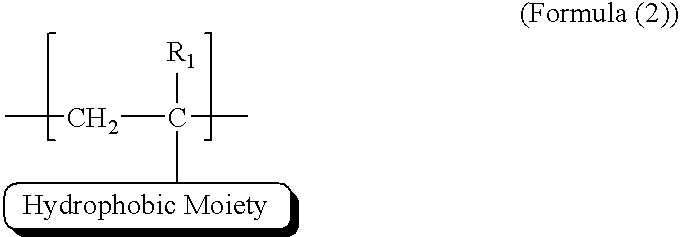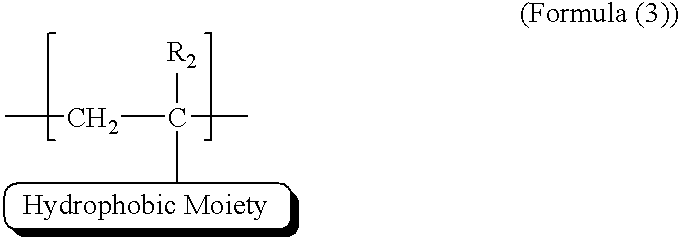Functional polymer for enhanced oil recovery
a technology of enhanced oil and functional polymers, applied in the field of oil production, can solve the problems of low recovery efficiency, limited incremental oil recovery, and chemical solutions for generating ultra low i
- Summary
- Abstract
- Description
- Claims
- Application Information
AI Technical Summary
Benefits of technology
Problems solved by technology
Method used
Image
Examples
examples
[0079]Example I. The representative examples of FPSs are conducted by the general laboratory methods consist of the following analysis:
[0080]1) Phase behavior is analyzed through methods known in the art (See the following references)[0081]a. Reed, R. L. and Healy, R. N.: “Some Physicochemical Aspects of Microemulsion Flooding.” Improved Oil Recovery by Surfactant and Polymer Flooding (D. O. Shah and R. S. Schechter, Eds), Academic Press, New York, N. Y. (1977) 383-437.[0082]b. Healy, R. N. and Reed, R. L.: “Physicochemical Aspects of Mictoremulsion Flooding,” Transactions, AIME, Volume 257 (1974) 491-501.[0083]c. Dreher, K. D. and Jones, S. C.: “An Approach to the Design of Fluids for Microemulsion Flooding,” Solution Chemistry of Surfactants, Volume 2 (K. L. Mittal, Editor), Plenum Publishing Corporation (1979).[0084]d. Healy, R. N., Reed, R. L., and Stenmark, D. G.: “Multiphase Microemulsion Systems,” Transactions, AIME, Volume 261 (1976) 147-160.[0085]e. Nelson, R. C. and Pope, ...
example 2
[0090]Six synthetic exemplary FPS samples were prepared via free radical initiated copolymerization (Table 1).
[0091]Step 1, according to the monomer ratio in the Table 1, the acrylamide, hydrophilic monomers, lipophilic monomers, and sodium carbonate were dissolved with deionized water to form a solution in a 3-neck round bottle flask, followed by sodium formate and ammonium hydroxide. The total mass of all reactants was about 25-30% of total mass of the solution in the flask.
[0092]Step 2, the flask was placed in water bath, and was deoxygenated with nitrogen flow for 20 minutes. Under nitrogen protection, the initiator system, including azo initiator (e.g. ABIN), reducer (e.g. sodium bisulfate), and oxidator (e.g., sodium persulfate), was added into the flask. The total mass of the initiator system was 0.01%-0.1% of the total mass of the total mass of all reactants.
[0093]Step 3, the flask was allowed to deoxygenate with nitrogen flow for another 10 minutes, and then the flask was s...
example 3
[0117]Coreflood tests were carried out at 185 F in epoxy-coated Berea sandstone 12 inch cores (average 487 md air permeability). The dry core was preflushed with 2 pore volumes of brine before it was flooded to an irreducible water saturation with a representative crude oil having a viscosity of about 7.2 cP. The oil saturation was typically from 0.65. The core was then waterflooded with the same brine to irreducible oil saturation (watercut 98%) of about 0.42 from 0.65.
[0118]The chemical flood began with the injection of a 0.3 pore volume slug of 1500 ppm FPS samples (FPS-1a, 1b, 1c, 2a, 2b, 2c in 6 separated coreflood tests) prepared with 0.5% NaCl brine, followed by 0.5% NaCl brine to irreducible oil saturation (watercut 98%). The resulting residue oil saturation is listed in the table 3.
[0119]A separated chemical flood began with the injection of a 0.3 pore volume slug of 1500 ppm PAM-25 (polyacrylamide, hydrolysis degree=23%, molecular weight 25 mil) prepared with 0.5% NaCl bri...
PUM
| Property | Measurement | Unit |
|---|---|---|
| Fraction | aaaaa | aaaaa |
| Fraction | aaaaa | aaaaa |
| Fraction | aaaaa | aaaaa |
Abstract
Description
Claims
Application Information
 Login to View More
Login to View More - R&D
- Intellectual Property
- Life Sciences
- Materials
- Tech Scout
- Unparalleled Data Quality
- Higher Quality Content
- 60% Fewer Hallucinations
Browse by: Latest US Patents, China's latest patents, Technical Efficacy Thesaurus, Application Domain, Technology Topic, Popular Technical Reports.
© 2025 PatSnap. All rights reserved.Legal|Privacy policy|Modern Slavery Act Transparency Statement|Sitemap|About US| Contact US: help@patsnap.com



